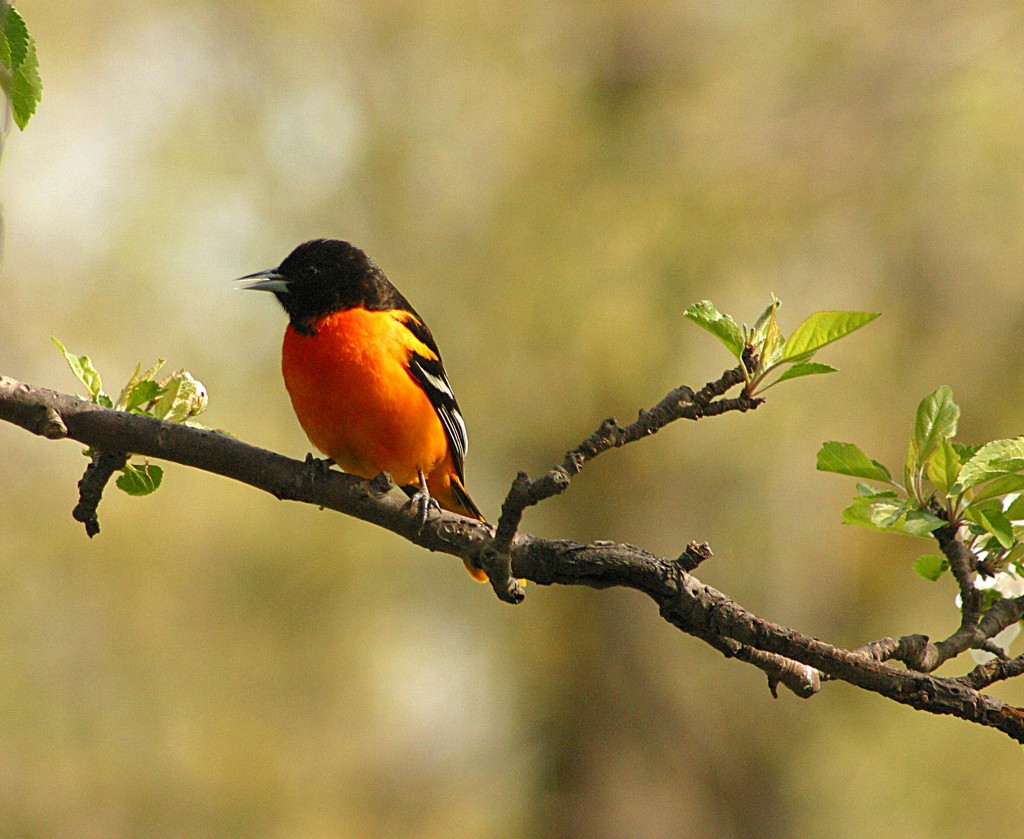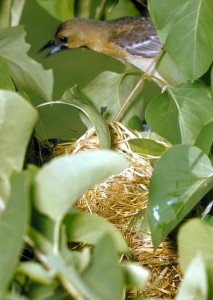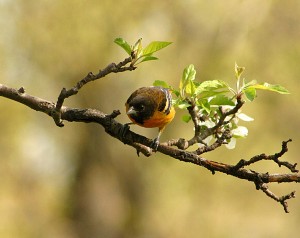Colorful Baltimore Orioles & Bird Population Trends
Baltimore Orioles are one of the most stunningly beautiful birds that spend their summers in our area. Their striking orange and black coloration is how they got their common name. When discovered by early English colonists along the Atlantic seaboard, they named the bird for the heraldic flag colors of the first Baron of Baltimore, George Calvert. That medieval-looking flag remains the state flag, and the Baltimore Oriole the state bird, of Maryland to this day.
Dark chestnut and black Orchard Orioles also grace our yards in summer. Both species have been summering in Monroe County for millennia and have been hanging around our back yards since the first yard went in during the early 1700’s. They winter in southern Mexico and Central American, arrive here in early May, breed and raise young, and migrate south again starting in August.
Their preferred habitat is woodland edges near open terrain, not deep in the forest, and they have adapted well to town life. They feed, mostly on insects rather than seeds, and nest high in treetops. They adore fruit and nectar, and most people get to see them when they poach nectar at hummingbird feeders.
A sure-fired way to get them down into your yard is to hang orange slices in trees or on posts, or better still, put some small dishes of jelly or jam outdoors. They prefer grape jelly or blackberry jam.
Members of the family Icteridae, orioles are closely related to our year-round resident blackbirds, grackles, cowbirds, and meadowlarks, and to bobolinks. Unlike their close cousins, orioles are known for their very bright colors, rich fluting songs, and their pendulous nests. Nests of Orchard Orioles generally are placed fairly low in trees or dense shrubs and are not as pouch-like in form as those of Baltimore Orioles, which often weave an eight-inch long nest high in trees. But their efforts at nest elongation are minor in comparison to those of either Altamira or Streak-back Orioles, as these two species build nests up to two feet long.
Both Orchard and Baltimore Oriole populations, in both breeding and wintering ranges, appear to be stable and in good health, probably because they are creatures of woodland edges and there is plenty of edge space with our current land use practices. Not all of our bird species population numbers, however, are in such good shape.
A great deal is known about bird populations in Illinois, perhaps more than in any other state. In addition to a remarkable collection of early bird surveys conducted in the 19th century in Illinois, the Illinois Natural History Survey, now a part of the University of Illinois, conducted three, state-wide, in depth bird studies at 50-year intervals, in 1906-1909, 1956-1958, and in 2006-2008.
We know that 439 species of birds have been observed at least once somewhere in the state. Of these, 139 species are accidental vagrants who, perhaps blown off course, show up in small numbers somewhere every couple of years. Three hundred species, however, are routine visitors, of which 194 species breed in the state, and 106 species migrate through Illinois. Of these 300 regularly occurring species in the state, 280 have been observed in the bluff lands area.
We also know, armed with the 150 years of solid survey data, a lot about population trends in Illinois. For example, the Eskimo Curlew, Passenger Pigeon, Carolina Parakeet and Ivory-billed Woodpecker are now extinct. Other species have been extirpated as a breeding species in the state. These include Trumpeter Swan, Sharp-tailed Grouse, Common Loon, Whooping Crane, Piping Plover, Long-billed Curlew, Common Raven, and Swallow-tailed Kite.
Other species are currently on the brink of extirpation: Greater Prairie-Chicken, Sandhill Crane, and Barn Owl. And several other species’ numbers are simply in serious decline. These include: Upland Sandpiper, American Bittern, King Rail, Loggerhead Shrike, Northern Bobwhite, Black-billed Cuckoo, Bewick’s Wren, Red-headed Woodpecker, and Cerulean Warbler.
On the other hand, some species are also increasing in population. Those found in our area include: Canada Goose, Wild Turkey, Bald Eagle, Black Vulture, Double-crested Cormorant and Wood Duck.
In addition, several species have greatly expanded their summertime ranges northward. In 1906, the Northern Cardinal was found only in the southern third of the state. By 1956, it was found in central and southern Illinois, and by 2006 it resided throughout the state. Red-bellied Woodpeckers, Tufted Titmice, Turkey Vultures, Carolina Wrens, Mourning Doves, and Yellow-breasted Chats are also expanding their ranges northward in the state.
Finally, several non-native bird species have been introduced to the state. Those found in locally include European Starling, House Sparrow, Rock Pigeon, Eurasian Collared-Dove, and, rarely, Ring-necked Pheasant and Eurasian Tree Sparrow.
What the future holds for birdlife in the bluff lands for the next 150 years is debatable. But we know we don’t hear Whip-poor-wills much anymore or see Evening Grosbeaks at our feeders like we used to. Those interested in learning more about changes in local birdlife attended a presentation by Dr. Mike Ward, ornithologist with the Illinois Natural History Survey, on Monday, June 14th 2010 at the Monroe County Annex Building, 901 Illinois Avenue, Waterloo. The presentation, part of the ongoing seminar series “Meet the Neighbors” co-hosted by Clifftop and the Monroe County University of Illinois Extension Service, was free and open to the public.
Clifftop, a local nonprofit organization, is focused on preserving and protecting area bluff lands.
A version of this article appeared in the June 4th 2010 edition of the Monroe County Independent.
© 2007 all content rights reserved, Clifftop NFP.
Comments are currently closed.



